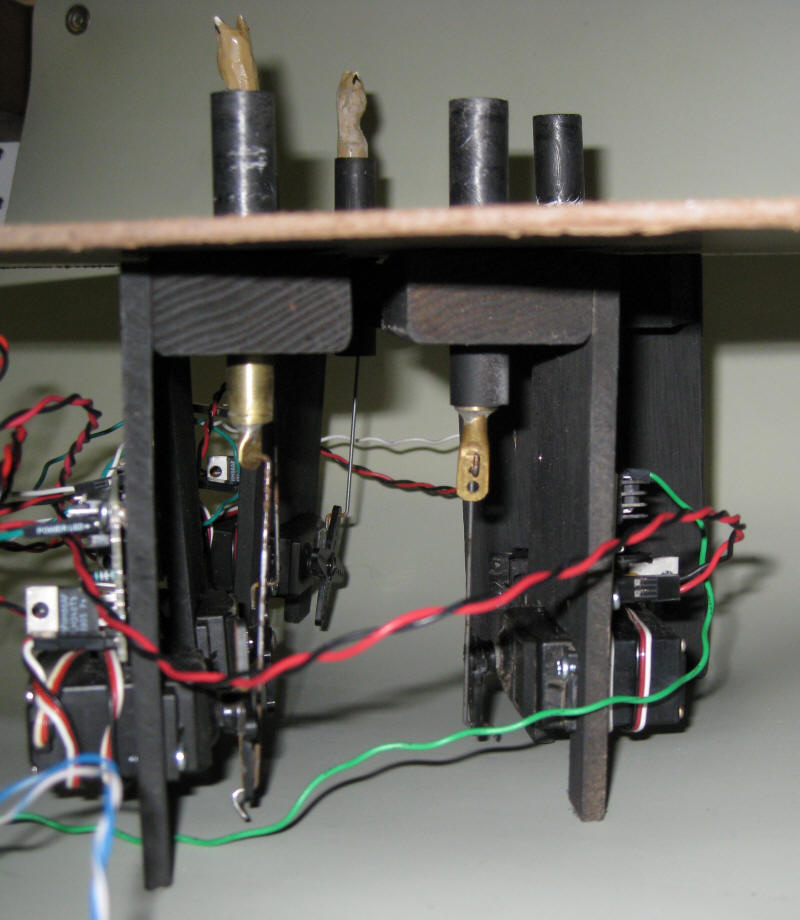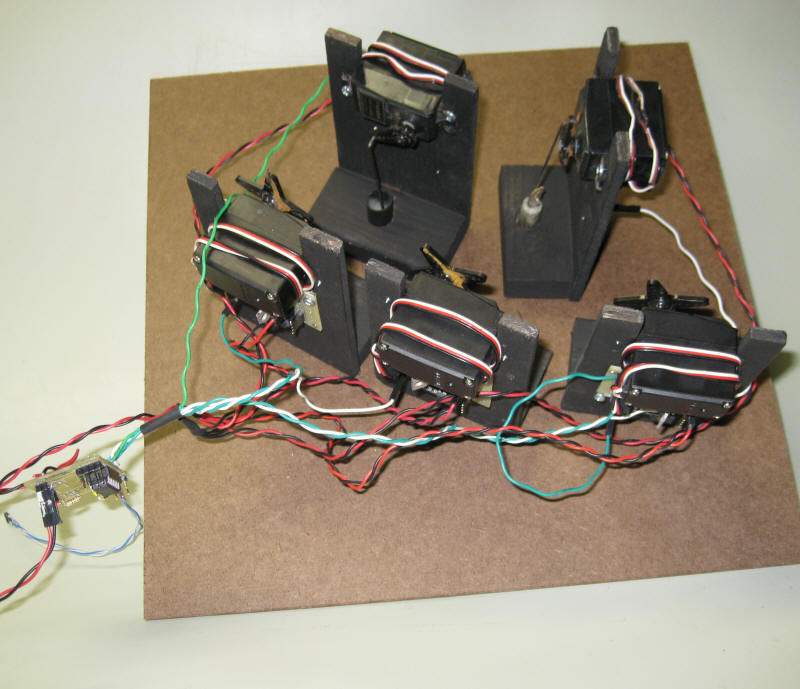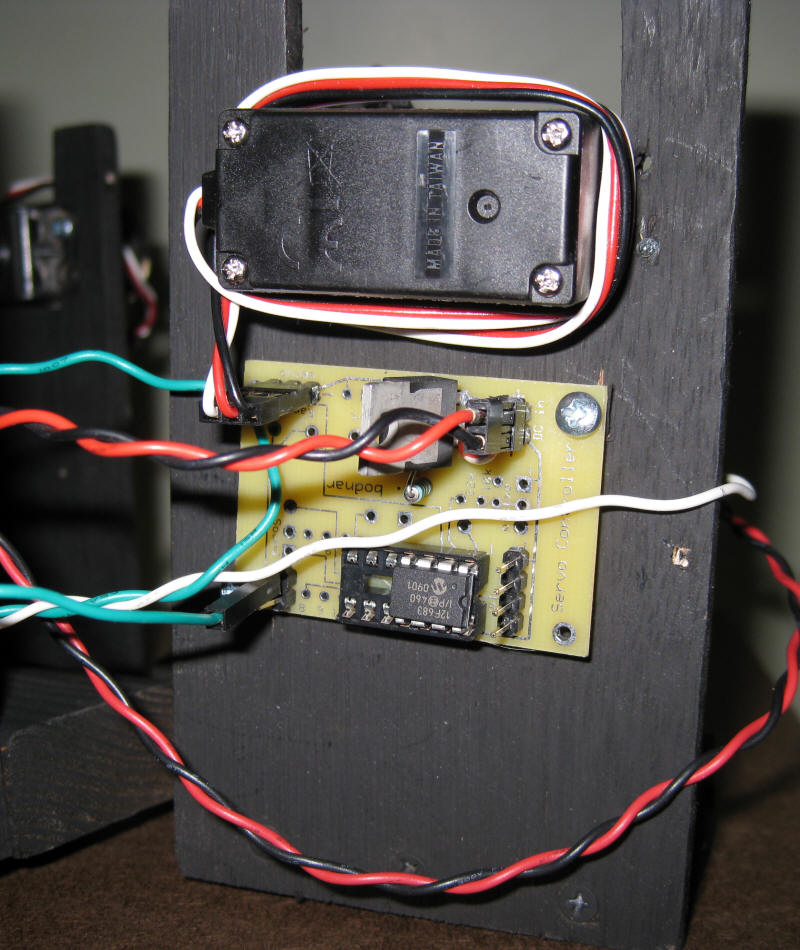| SOFTWARE
Servo RECEIVING Unit
'd. bodnar revised 3-8-09
' up on serial port #1, down on serial #2, up fast on #3, down fast
on #4
'Note2: GPIO.3 can't be connected to IR sensor while using ICSP
@ DEVICE MCLR_OFF
ansel = 0 'all inputs digital
cmcon0 = 7
'Include "modedefs.bas"
define ADC_BITS 12
define ADC_CLOCK 3
define ADC_SAMPLEUS 50
ADCON0=0 'analog
Audio var gpio.0 'pin 7
Trigger var gpio.3 'pin 4
ServoPin var gpio.4 'pin 3
NotUsed var gpio.5 'pin 2
Temp var word
Temp2 var word
Range var word
CWMin var word
CCWMax var word
Move var byte
DownFlag var bit
UpFlag var bit
CCWMax = 300 '225 manual recommended max
CWMin = 10 '75 manual recommended min
RangeMax con 170
CCW var word 'where to start rotation
CW var word
Delay con 10
gpio = %00001110 '1, 2, 3 inputs other outputs
downflag= 0:upflag= 0
cw= 90
ccw=240
gosub down
NewStart:
serin trigger, 6, ["ABC"], Move
if move = 1 then
gosub up
endif
if move =2 then
gosub down
endif
if move = 3 then
gosub up_fast
endif
if move = 4 then
gosub down_fast
endif
goto newstart:
Test:
serout notused ,6, ["Top ",10,13]
gosub up:pause 2000:gosub down:pause 2000
gosub up_fast:pause 2000:gosub down_fast:pause 2000
goto test:
Start:
LOW ServoPin 'relax servo
IF Trigger = 0 THEN gosub DogDown
if trigger = 1 then gosub DogUp
goto Start ' wait till button pressed
DogDown:
'serout notused ,6, ["Down "]
if downflag=1 then return
gosub down
downflag=1
upflag=0
return
DogUp:
'serout notused ,6, ["Up "]
if upflag=1 then return
gosub up
upflag=1
downflag=0
return
gosub up
pause 1500
gosub down
goto start:
Down:
serout notused ,6, ["Down "]
HIGH Audio
FOR Temp = CCW TO CW Step -1
pulsout servopin, temp
PAUSE Delay
NEXT Temp
LOW Audio
return
pause 1500
Up:
serout notused ,6, ["Up "]
'move prairie dog Up
FOR Temp=CW TO CCW Step 1
pulsout ServoPin, Temp
PAUSE Delay
NEXT Temp
return
PAUSE 1500
GOTO Start:
'cw= 90
'ccw=240
Down_Fast:
serout notused ,6, ["Down Fast "]
'move prairie dog Down FAST
HIGH Audio
for temp = 1 to 40
pulsout servopin, cw
pause delay
next temp
LOW Audio
return
pause 1500
Up_Fast:
serout notused ,6, ["Up Fast "]
'move prairie dog Up FAST
FOR Temp=1 to 40
pulsout ServoPin, CCW
pause delay
NEXT Temp
return
pulsout servopin, CCW
PAUSE 1500
GOTO Start:
Master CONTROL Unit
' d bodnar - 3-8-09
' sent up on serial port #1, down on serial #2, up fast on #3, down
fast on #4
DEFINE DEBUG_REG PORTA
DEFINE DEBUG_BIT 5 ' PIN 2 on 16f684
DEFINE DEBUG_BAUD 9600
DEFINE DEBUG_MODE 1 ' Set Debug mode: 0 = true, 1 = inverted
ansel=0 'allows you to use pins as digital rather than analog
'Note- this combination of output pins works properly!
Trigger var byte(6)
trigger(1)=11 'portc.3 ' pin 7
trigger(2)=10 'portc.2 ' pin 8
trigger(3)=12 'portc.4 'pin 6
trigger(4)=13 'portc.5 'pin 5
trigger(5)= 2 'porta.2 'pin 11
temp var byte
temp2 var byte
temp3 var byte
temp4 var byte
RNDmtemp var word
Move var byte
flag var bit [6] 'flag =0 if down / =1 if up
trisc = %00000000
trisa = %00000000
for temp=1 to 5:flag(temp)=0:next temp
debug 13,10,13,10,"(C) 2009 - d. bodnar - ver 4.1",10,13,"Prairie
Dog Master Controller",13,10,"TrainElectronics.com",13,10
pause 5000 'wait for remote units to wake up
debug "all up", 10,13
gosub all_up
pause 2000
debug "all down fast", 10,13
gosub all_down_fast
pause 2000
Top:
gosub getrandom2digit
if temp2 >=1 and temp2 <= 5 then 'send dog up
if flag(temp2)=0 then
serout trigger(temp2), 6,[ "ABC",1]
pause 20
serout trigger(temp2), 6,[ "ABC",1]
debug 10,13,#temp2," up ",#flag(temp2),10,13
flag(temp2)=1
endif
endif
if temp2 >=6 and temp2 <= 10 then 'send dog down
if flag(temp2-5)=1 then
serout trigger(temp2-5), 6, [ "ABC",2]
pause 20
serout trigger(temp2-5), 6, [ "ABC",2]
debug 10,13, #(temp2-5)," down ",#flag(temp2-5),10,13
flag(temp2-5)=0
endif
endif
if temp2 = 11 then 'if at least 3 up send all down fast
if temp3 >=3 then
gosub all_down_fast
debug "All Down Fast", 10,13
endif
endif
if temp2>0 and temp2<=11 then
temp3=0:for temp4=1 to 5:temp3=temp3+flag(temp4):next
debug " ttl= ",#temp3
pause 1500
endif
goto top:
All_Down:
for temp=1 to 5:flag(temp)=0:
Move = 2
serout trigger(temp), 6,[ "ABC",move]
next temp
return
All_up:
for temp=1 to 5:flag(temp)=1:
Move = 1
serout trigger(temp), 6,[ "ABC",move]
next temp
return
All_Down_fast:
for temp=1 to 5:flag(temp)=0:
Move = 4
serout trigger(temp), 6, [ "ABC",move]
next temp
return
All_Up_Fast:
for temp=1 to 5:flag(temp)=1:
Move = 3
serout trigger(temp), 6, [ "ABC",move]
next temp
return
GetRandom2Digit: ' random #s from 0 - 99
for temp=1 to 10
random rndmtemp 'reset seed
temp2=rndmtemp dig 2
temp2=temp2*10
temp2=temp2+ rndmtemp dig 1
pause 10
next temp
temp2=temp2+0 'remove zeros
if temp2 <= 12 and temp2<>0 then
endif
return
|



